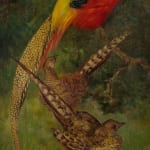Theo van Hoytema (1863-1917)
Theo van Hoytema was born in The Hague as the youngest in a family with seven siblings. Orphaned at a young age, Hoytema decided early on his destiny as an artist. By 1890, Hoytema established a studio in a garden house near Castle De Brinckhorst, outside of The Hague. The Dutch tradition of devotion to images of the natural world surely contributed to Hoytema’s early success. Like many other artists, Hoytema was drawn to working in Amsterdam’s famous zoo Artis and almost his entire output—paintings, drawings, graphic work or applied arts—have flora and fauna as a subject. The influence of English illustrators such as Walter Crane and Japanese prints are apparent, as are the Art Nouveau stylized elements prevalent at the turn of the century.
With a focus on graphic works, Hoytema kept his sketches and drawings mounted in portfolios organized by subject spanning a period of three decades.[1] Rarely did he sign or date drawings, making it difficult to establish a chronology. Suffering from a chronic illness and depression, Hoytema’s artistic output continued, although he was hospitalized for much of 1904 and 1905. During his lifetime, in 1900, an auction with over seventy works was organized at Frederik Muller & Cie in Amsterdam, possibly to support the sickly artist.
When Hoytema died in 1917, as per his wish, the majority of his work entered the collections of the Kunstmuseum in The Hague and the Rijksmuseum in Amsterdam, while over one-hundred drawings were sold at auction. His favorite subject matter was the animal kingdom, often portrayed as funny characters, appearing on his popular calendars, original artworks and decorative arts, including ceramics and furniture.
Especially drawn to birds, as pointed out by Jan Veth in the introduction to the 1900 sale, Hoytema’s first lithographed booklet Hoe de vogels aan hun koning kwamen (how the birds got their king) was dedicated to his feathered friends. In 1892, it was the first Dutch attempt to integrate text and illustration into one publication. The same year, Hoytema gained great fame with his lithographed illustrations in Hans Christian Andersen’s fairy tale The Ugly Duckling, followed by several more bird-themed picture books. Hoytema was certainly a versatile artist: that same year, he also produced the exceptional painting Return of the Stork, now in the Boijmans van Beuningen Museum.
[1] Marjan Boot, Theo van Hoytema 1863-1917, Zwolle 1999, pp. 97-117



